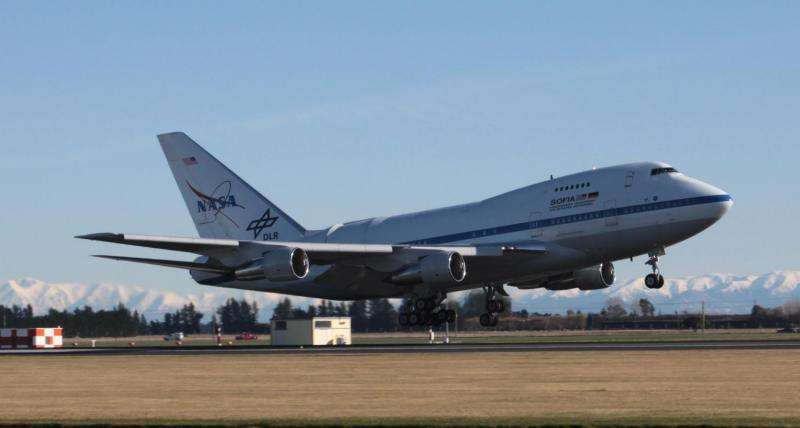SOFIA heads to New Zealand to study Southern Hemispheric skies

The Stratospheric Observatory for Infrared Astronomy, SOFIA, arrived in Christchurch, New Zealand, to study the Southern Hemisphere's skies June 6.
For the next eight weeks, the aircraft-based observatory will operate from the U.S. National Science Foundation's Antarctic Program facility at Christchurch International Airport. The airborne platform puts the observatory above 99% of Earth's infrared-blocking water vapor, and enables it to conduct observations from almost anywhere in the world. When flying from New Zealand, astronomers on board SOFIA can study celestial objects that are best observed from southern latitudes, such as star formation within the Magellanic Clouds.
The Magellanic Clouds are two satellite galaxies of our Milky Way Galaxy. From the aircraft's home base in California, scientists on SOFIA typically study star formation within the Milky Way, but flying in the Southern Hemisphere gives scientists a view of star formation within these neighboring galaxies. Comparing stellar evolution in the Magellanic Clouds and the Milky Way enables scientists to better understand how the earliest generations of stars in our universe formed.
"It's hard to beat the quality of the science data that we obtain while observing from New Zealand," said Program Manager Eddie Zavala, "We are looking forward to another outstanding series of observations."
This year's observations follow Southern observing flights last year, which included studying Pluto's atmosphere just two weeks before NASA's New Horizons mission made its nearest approach to Pluto. The next eight weeks include 24 observing flights, using three of the observatory's seven instruments. Because it's based on an aircraft, SOFIA can carry heavier, more powerful instruments than spaced-based observatories. These instruments can also be changed and upgraded to accommodate a variety of observations
SOFIA is a Boeing 747SP jetliner modified to carry a 100-inch diameter telescope. It is a joint project of NASA and the German Aerospace Center. NASA's Ames Research Center in California's Silicon Valley manages the SOFIA program, science and mission operations in cooperation with the Universities Space Research Association headquartered in Columbia, Maryland, and the German SOFIA Institute (DSI) at the University of Stuttgart. The aircraft is based at NASA's Armstrong Flight Research Center's Hangar 703, in Palmdale, California.
Provided by NASA





















